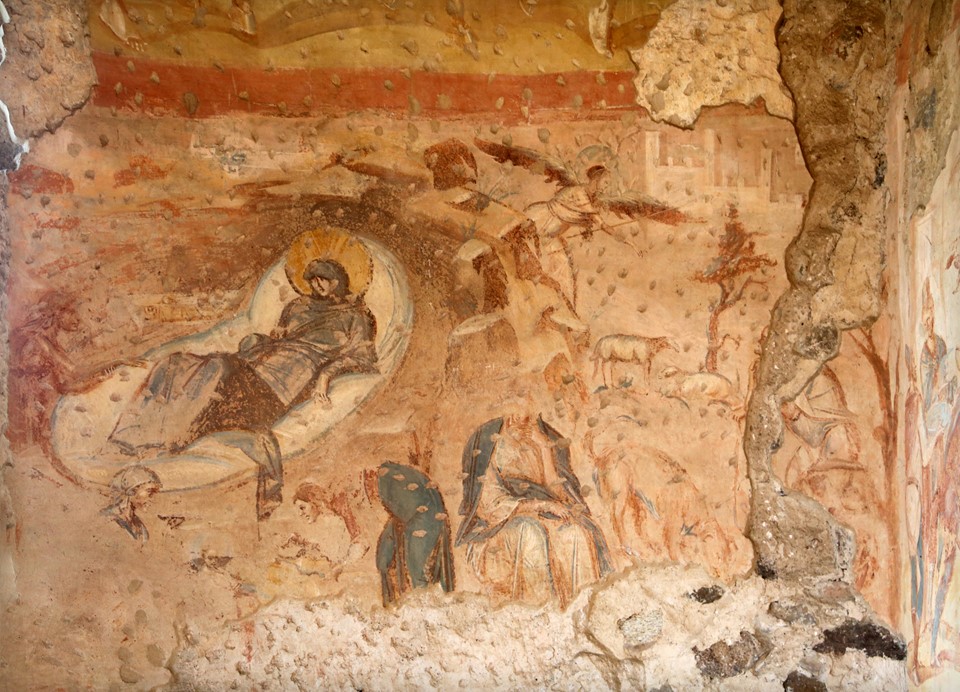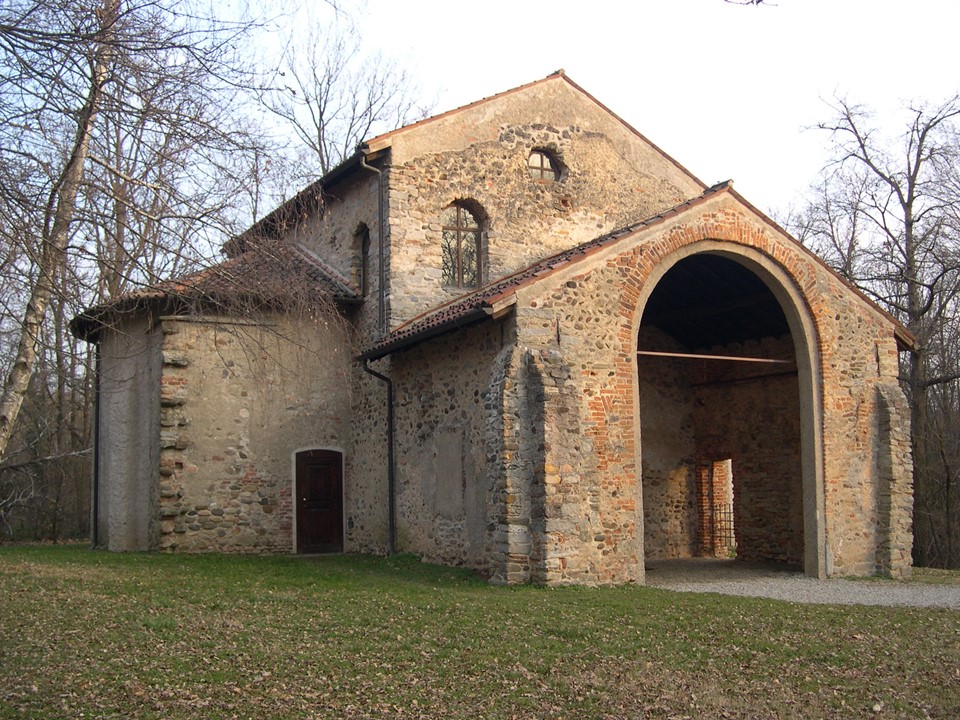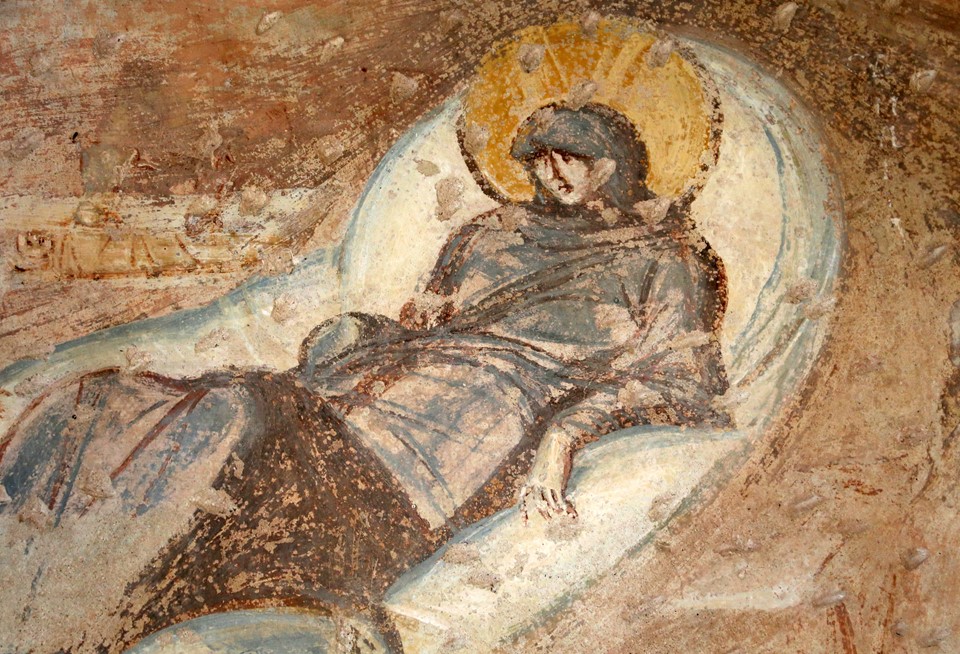
https://upload.wikimedia.org/wikipedia/commons/5/5c/Maestro_di_castelseprio%2C_storie_dell%27infanzia_di_cristo%2C_datazione_incerta_tra_l%27830_e_il_950_dc_ca.%2C_15_nativit%C3%A0_1.jpg
I have been fascinated by the Castelseprio frescoes since I was a student, and I was introduced to their unique beauty and… ‘mysteries!’ When I finally visited Castelseprio in 1988, inside this amazing Church, enveloped in their splendor… I was transfixed, spellbound, awe-struck, entranced… forever. Years passed by, and I yearn to visit Castelseprio once more… stand in the middle of the Church, and experience… moments of the sublime.

https://commons.wikimedia.org/wiki/File:Santa_Maria_foris_portas2.JPG
When the extraordinary Mariological programme of paintings on the walls of the church of Santa Maria foris portas at Castelseprio was first uncovered, and then quickly made known to the art historical community in an exemplary publication, historians of early medieval art were transfixed. Here was the missing link, the key which would provide the key which would provide the means to unlocking and understanding the role that the classical Byzantine tradition of art, played in the evolution of elite artistic developments in the various theatres of state formations in post-Roman western Europe, from papal Rome to Carolingian Aachen and Northumbrian Lindisfarne, in the early medieval centuries. The artists responsible appeared to be masters of an almost undiluted tradition of Greco-Roman painting, testifying to the enduring existence of a strain of what has been designated by Ernst Kitzinger as ‘perennial Hellenism’, continuing unbroken in one or more centers in the eastern Mediterranean and potentially available to the artist in western Europe, minded to recover some of the elements of ancient classical practice in an age in which overt classical form and subject-matter were valued at a high premium in the rival courts of Europe… write John Mitchell and Beatrice Leal… and I can not think of a better introduction to my Christmas POST on Santa Maria foris portas at Castelseprio Nativity Scene. https://www.academia.edu/13897079/_Co-authored_with_John_Mitchell_Wall_pantings_in_S._Maria_foris_portas_Castelseprio_and_the_tower_at_Torba._Reflections_and_reappraisal._In_Castelseprio_e_Torba_sintesi_delle_ricerche_e_aggiornamenti_ed._Paola_Marina_de_Marchi_2013

https://upload.wikimedia.org/wikipedia/commons/1/11/Maestro_di_castelseprio%2C_storie_dell%27infanzia_di_cristo%2C_datazione_incerta_tra_l%27830_e_il_950_dc_ca.%2C_15_nativit%C3%A0_3.jpg
The Church of at Castelseprio is so special and unique, many great scholars of Byzantine Art wrote about it… one way or another, more or less. I am fascinated by the surviving frescoes within the Church, the “ambiance” they create, their “Hellenistic” origin, stylistic characteristics (brushwork, colour, light), and drama in their compositions. I find it irresistible how the unknown “Greek” painter of the time, used diagonal perspective, a three-quarter view of both persons and objects, and a constant search for depth of space, to enhance his brilliant style. In compositions like the Nativity scene, I admire the portrayal of illusionistic forms within a deep, open landscape, and how the master artist used illusionism to enhance and at the same time, transfigure reality. I like… everything!
Merry Christmas
Preparing for this POST (this is the most important part for every BLOG POST of mine)… wondering how “Hellenistic,” in rendering and mood, the Castelseprio frescos are… I reread The Hellenistic Heritage in Byzantine Art, by Ernst Kitzinger, Dumbarton Oaks Papers, Vol. 17 (1963), pp. 95-115 (37 pages) https://www.jstor.org/stable/1291192?seq=13#metadata_info_tab_contents , and Castelseprio and the Byzantine “Renaissance,” by Charles R. Morey, The Art Bulletin Vol. 34, No. 3 (Sep. 1952), pp. 173-201 (37 pages), https://www.jstor.org/stable/3047419?seq=1#metadata_info_tab_contents
For a PowerPoint on Castelseprio’s Nativity Scene, please… Check HERE!